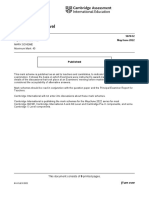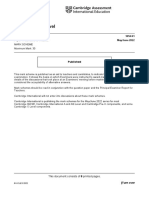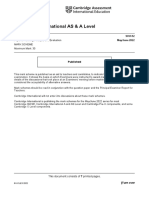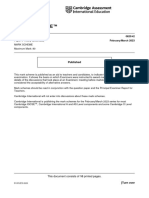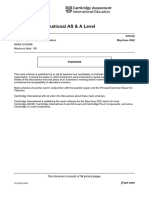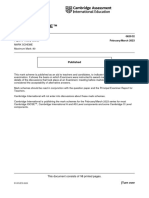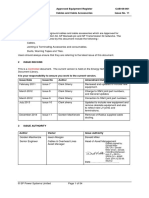Cambridge O Level: Chemistry 5070/42 May/June 2022
Cambridge O Level: Chemistry 5070/42 May/June 2022
Uploaded by
Saeed RehmanCopyright:
Available Formats
Cambridge O Level: Chemistry 5070/42 May/June 2022
Cambridge O Level: Chemistry 5070/42 May/June 2022
Uploaded by
Saeed RehmanOriginal Title
Copyright
Available Formats
Share this document
Did you find this document useful?
Is this content inappropriate?
Copyright:
Available Formats
Cambridge O Level: Chemistry 5070/42 May/June 2022
Cambridge O Level: Chemistry 5070/42 May/June 2022
Uploaded by
Saeed RehmanCopyright:
Available Formats
Cambridge O Level
CHEMISTRY 5070/42
Paper 4 Alternative to Practical May/June 2022
MARK SCHEME
Maximum Mark: 60
Published
This mark scheme is published as an aid to teachers and candidates, to indicate the requirements of the
examination. It shows the basis on which Examiners were instructed to award marks. It does not indicate the
details of the discussions that took place at an Examiners’ meeting before marking began, which would have
considered the acceptability of alternative answers.
Mark schemes should be read in conjunction with the question paper and the Principal Examiner Report for
Teachers.
Cambridge International will not enter into discussions about these mark schemes.
Cambridge International is publishing the mark schemes for the May/June 2022 series for most
Cambridge IGCSE, Cambridge International A and AS Level and Cambridge Pre-U components, and some
Cambridge O Level components.
This document consists of 9 printed pages.
© UCLES 2022 [Turn over
5070/42 Cambridge O Level – Mark Scheme May/June 2022
PUBLISHED
Generic Marking Principles
These general marking principles must be applied by all examiners when marking candidate answers. They should be applied alongside the
specific content of the mark scheme or generic level descriptors for a question. Each question paper and mark scheme will also comply with these
marking principles.
GENERIC MARKING PRINCIPLE 1:
Marks must be awarded in line with:
the specific content of the mark scheme or the generic level descriptors for the question
the specific skills defined in the mark scheme or in the generic level descriptors for the question
the standard of response required by a candidate as exemplified by the standardisation scripts.
GENERIC MARKING PRINCIPLE 2:
Marks awarded are always whole marks (not half marks, or other fractions).
GENERIC MARKING PRINCIPLE 3:
Marks must be awarded positively:
marks are awarded for correct/valid answers, as defined in the mark scheme. However, credit is given for valid answers which go beyond the
scope of the syllabus and mark scheme, referring to your Team Leader as appropriate
marks are awarded when candidates clearly demonstrate what they know and can do
marks are not deducted for errors
marks are not deducted for omissions
answers should only be judged on the quality of spelling, punctuation and grammar when these features are specifically assessed by the
question as indicated by the mark scheme. The meaning, however, should be unambiguous.
GENERIC MARKING PRINCIPLE 4:
Rules must be applied consistently, e.g. in situations where candidates have not followed instructions or in the application of generic level
descriptors.
© UCLES 2022 Page 2 of 9
5070/42 Cambridge O Level – Mark Scheme May/June 2022
PUBLISHED
GENERIC MARKING PRINCIPLE 5:
Marks should be awarded using the full range of marks defined in the mark scheme for the question (however; the use of the full mark range may
be limited according to the quality of the candidate responses seen).
GENERIC MARKING PRINCIPLE 6:
Marks awarded are based solely on the requirements as defined in the mark scheme. Marks should not be awarded with grade thresholds or
grade descriptors in mind.
© UCLES 2022 Page 3 of 9
5070/42 Cambridge O Level – Mark Scheme May/June 2022
PUBLISHED
Science-Specific Marking Principles
1 Examiners should consider the context and scientific use of any keywords when awarding marks. Although keywords may be present, marks
should not be awarded if the keywords are used incorrectly.
2 The examiner should not choose between contradictory statements given in the same question part, and credit should not be awarded for any
correct statement that is contradicted within the same question part. Wrong science that is irrelevant to the question should be ignored.
3 Although spellings do not have to be correct, spellings of syllabus terms must allow for clear and unambiguous separation from other syllabus
terms with which they may be confused (e.g. ethane / ethene, glucagon / glycogen, refraction / reflection).
4 The error carried forward (ecf) principle should be applied, where appropriate. If an incorrect answer is subsequently used in a scientifically
correct way, the candidate should be awarded these subsequent marking points. Further guidance will be included in the mark scheme where
necessary and any exceptions to this general principle will be noted.
5 ‘List rule’ guidance
For questions that require n responses (e.g. State two reasons …):
The response should be read as continuous prose, even when numbered answer spaces are provided.
Any response marked ignore in the mark scheme should not count towards n.
Incorrect responses should not be awarded credit but will still count towards n.
Read the entire response to check for any responses that contradict those that would otherwise be credited. Credit should not be
awarded for any responses that are contradicted within the rest of the response. Where two responses contradict one another, this
should be treated as a single incorrect response.
Non-contradictory responses after the first n responses may be ignored even if they include incorrect science.
© UCLES 2022 Page 4 of 9
5070/42 Cambridge O Level – Mark Scheme May/June 2022
PUBLISHED
6 Calculation specific guidance
Correct answers to calculations should be given full credit even if there is no working or incorrect working, unless the question states ‘show
your working’.
For questions in which the number of significant figures required is not stated, credit should be awarded for correct answers when rounded by
the examiner to the number of significant figures given in the mark scheme. This may not apply to measured values.
For answers given in standard form (e.g. a 10n) in which the convention of restricting the value of the coefficient (a) to a value between 1
and 10 is not followed, credit may still be awarded if the answer can be converted to the answer given in the mark scheme.
Unless a separate mark is given for a unit, a missing or incorrect unit will normally mean that the final calculation mark is not awarded.
Exceptions to this general principle will be noted in the mark scheme.
7 Guidance for chemical equations
Multiples / fractions of coefficients used in chemical equations are acceptable unless stated otherwise in the mark scheme.
State symbols given in an equation should be ignored unless asked for in the question or stated otherwise in the mark scheme.
© UCLES 2022 Page 5 of 9
5070/42 Cambridge O Level – Mark Scheme May/June 2022
PUBLISHED
Question Answer Marks
1(a) A burette (1) 3
B pipette (1)
C conical flask / Erlenmeyer flask (1)
1(b)(i) provide H+ 1
1(b)(ii) (from) colourless (to) (pale) pink 1
1(b)(iii) 3
titration number 1 2 3 4
final reading / cm3 27.1
initial reading / cm3 1.7 0.3
volume used / cm3 25.4 25.1
best titration results ()
M1 final and initial readings correct in column 1 (1)
M2 volume used correct in column 1 (1)
M3 25.1 and 0.3 in columns 3 and 4 (1)
1(b)(iv) 24.7 (cm3) 1
1(c)(i) M1 1.08/90 OR 0.012 (1) 2
M2 (0.012 ÷ 10 =) 0.0012/1.2 10–3 (1)
1(c)(ii) 0.00048 / 4.8 10–4 1
1(c)(iii) 0.0196 1
1(c)(iv) 3.09 / 3.10 1
© UCLES 2022 Page 6 of 9
5070/42 Cambridge O Level – Mark Scheme May/June 2022
PUBLISHED
Question Answer Marks
2(a)(i) M1 white precipitate (1) 4
M2 dissolves/soluble (1)
M3 colourless solution (1)
M4 Zn2+ (1)
2(a)(ii) M1 white precipitate (1) 2
M2 insoluble (in excess) (1)
2(a)(iii) M1 sulfur dioxide / SO2 (1) 2
M2 sulfite / SO32– (1)
2(a)(iv) iodide / I– 1
2(b) M1 add water to the mixture (1) 6
M2 stir / heat / shake
(water and the mixture) (1)
M3 filter
(barium sulfate) (1)
M4 wash the residue
or wash barium sulfate with distilled water and dry e.g. between filter papers (1)
M5 heat the filtrate / heat aqueous sodium chloride / heat sodium chloride solution (1)
M6 until crystallisation point / saturation point / to dryness (1)
Question Answer Marks
3(a)(i) exothermic / neutralisation 1
3(a)(ii) pipette / burette 1
3(a)(iii) burette 1
© UCLES 2022 Page 7 of 9
5070/42 Cambridge O Level – Mark Scheme May/June 2022
PUBLISHED
Question Answer Marks
3(a)(iv) M1 heat loss (1) 2
M2 use a polystyrene cup / plastic cup / insulate the beaker (1)
3(a)(v) M1 points at 0, 4, 8, 12 and 16 plotted correctly (first 5) (1) 2
M2 points at 20, 24, 28 and 32 plotted correctly (last 4) (1)
3(a)(vi) circle the second point 1
3(a)(vii) best fit line ignoring anomalous point 1
3(a)(viii) M1 second best fit line (1) 2
M2 lines extended to intersect (1)
3(a)(ix) 17.4 (cm3) 1
3(a)(x) (33.2 – 24.5) = 8.7 (°C) 1
3(a)(xi) (25 + 17.4 =) 42.4 (g) 1
3(b) heat loss 1
© UCLES 2022 Page 8 of 9
5070/42 Cambridge O Level – Mark Scheme May/June 2022
PUBLISHED
Question Answer Marks
4(a) M1 anode (1) 2
M2 cathode (1)
4(b)(i) M1 H+ + e on LHS 2
M2 2H+ + 2e H2 fully correct
4(b)(ii) oxygen 4
M1 glowing splint (1)
M2 relights (1)
hydrogen
M3 burning splint (1)
M4 pop (1)
Question Answer Marks
5(a) gas syringe 1
5(b) (avoids) loss of gas 1
5(c)(i) (horizontal) time / s 1
AND
(vertical) volume (of gas / carbon dioxide / CO2) / cm3
5(c)(ii) M1 solid disappears (1) 3
M2 effervescence / fizzing / bubbling (1)
M3 solution turns blue (1)
5(c)(iii) M1 rate decreases (1) 2
M2 as concentration of acid decreases or
as gradient decreases / becomes less steep (1)
© UCLES 2022 Page 9 of 9
You might also like
- XERO 2+1 WorkoutsDocument28 pagesXERO 2+1 WorkoutsHervian Dirgantara Putra100% (5)
- Cambridge O Level: Biology 5090/42Document9 pagesCambridge O Level: Biology 5090/42afsheen24akramNo ratings yet
- Schema Therapy Children PDFDocument38 pagesSchema Therapy Children PDFmina mirNo ratings yet
- Development of Uterus and Congenital Anomalies: Done By: Jabir AL Araimi ID# 0333145Document21 pagesDevelopment of Uterus and Congenital Anomalies: Done By: Jabir AL Araimi ID# 0333145jabirNo ratings yet
- Cambridge O Level: Chemistry 5070/32 October/November 2022Document7 pagesCambridge O Level: Chemistry 5070/32 October/November 2022Ankit MistryNo ratings yet
- Cambridge O Level: Chemistry 5070/41 May/June 2022Document10 pagesCambridge O Level: Chemistry 5070/41 May/June 2022Saeed RehmanNo ratings yet
- Cambridge O Level: Chemistry 5070/32 May/June 2022Document9 pagesCambridge O Level: Chemistry 5070/32 May/June 2022Saeed RehmanNo ratings yet
- Screenshot 2024-10-03 at 4.18.20 PMDocument8 pagesScreenshot 2024-10-03 at 4.18.20 PMKhurram AwanNo ratings yet
- 5070 s22 Ms 22 PDFDocument12 pages5070 s22 Ms 22 PDFKhubaib KhanNo ratings yet
- 0620 w21 Ms 62 PDFDocument8 pages0620 w21 Ms 62 PDFEndeavor Med TutorsNo ratings yet
- Cambridge International AS & A Level: Chemistry 9701/34 May/June 2022Document10 pagesCambridge International AS & A Level: Chemistry 9701/34 May/June 2022Labiba GulNo ratings yet
- 0620 m23 Ms 62 PDFDocument8 pages0620 m23 Ms 62 PDF4yqyt65q8xNo ratings yet
- Cambridge International AS & A Level: Chemistry 9701/52 May/June 2021Document9 pagesCambridge International AS & A Level: Chemistry 9701/52 May/June 2021icqq9qjw3No ratings yet
- Cambridge International AS & A Level: Biology 9700/34 May/June 2022Document8 pagesCambridge International AS & A Level: Biology 9700/34 May/June 2022mariakhan.educationNo ratings yet
- Cambridge International AS & A Level: Chemistry 9701/52Document7 pagesCambridge International AS & A Level: Chemistry 9701/52mutambanesangokNo ratings yet
- Paper 3 Practical Test 5070 - 31 - MARK SCHEMEDocument8 pagesPaper 3 Practical Test 5070 - 31 - MARK SCHEMEPrefrontal Learning CenterNo ratings yet
- Cambridge O Level: Chemistry 5070/42Document7 pagesCambridge O Level: Chemistry 5070/42Maheen BilalNo ratings yet
- Cambridge O Level: Physics 5054/41 May/June 2022Document8 pagesCambridge O Level: Physics 5054/41 May/June 2022Haroon MehmoodNo ratings yet
- Cambridge O Level: Chemistry 5070/41 October/November 2022Document10 pagesCambridge O Level: Chemistry 5070/41 October/November 2022jamshedNo ratings yet
- 5054_w22_ms_42Document7 pages5054_w22_ms_42Hummayal TariqNo ratings yet
- Cambridge O Level: Chemistry 5070/41 October/November 2022Document10 pagesCambridge O Level: Chemistry 5070/41 October/November 2022Ankit MistryNo ratings yet
- Cambridge O Level: Chemistry 5070/22Document12 pagesCambridge O Level: Chemistry 5070/22alisacarol46No ratings yet
- Cambridge International AS & A Level: Chemistry 9701/21 May/June 2022Document10 pagesCambridge International AS & A Level: Chemistry 9701/21 May/June 2022Jjuuko JeremiahNo ratings yet
- Cambridge O Level: Subject 5054/42 May/June 2022Document7 pagesCambridge O Level: Subject 5054/42 May/June 2022Imran MuhammadNo ratings yet
- Cambridge International AS & A Level: Chemistry 9701/21 May/June 2021Document10 pagesCambridge International AS & A Level: Chemistry 9701/21 May/June 2021fairooznawarNo ratings yet
- Cambridge O Level: Chemistry 5070/42 May/June 2020Document8 pagesCambridge O Level: Chemistry 5070/42 May/June 2020Fizza SyedNo ratings yet
- Cambridge IGCSE™: Chemistry 0620/61Document7 pagesCambridge IGCSE™: Chemistry 0620/61tawana.tachiveyiiNo ratings yet
- Cambridge O Level: Chemistry 5070/32 May/June 2020Document7 pagesCambridge O Level: Chemistry 5070/32 May/June 2020iramtahiraNo ratings yet
- Cambridge IGCSE ™: ChemistryDocument10 pagesCambridge IGCSE ™: ChemistryMohammed khaled GhazalNo ratings yet
- 0610 m22 Ms 32 PDFDocument11 pages0610 m22 Ms 32 PDFsolihinNo ratings yet
- Cambridge International AS & A Level: Chemistry 9701/52 May/June 2022Document7 pagesCambridge International AS & A Level: Chemistry 9701/52 May/June 2022Fupeng MouNo ratings yet
- Cambridge O Level: Chemistry 5070/41 October/November 2020Document9 pagesCambridge O Level: Chemistry 5070/41 October/November 2020Islamabad ALMA SchoolNo ratings yet
- Cambridge International AS & A Level: Chemistry 9701/52 March 2020Document8 pagesCambridge International AS & A Level: Chemistry 9701/52 March 2020Yue ShiNo ratings yet
- Cambridge IGCSE ™: ChemistryDocument10 pagesCambridge IGCSE ™: ChemistryNiki SNo ratings yet
- Cambridge International AS & A Level: Chemistry 9701/21 May/June 2020Document10 pagesCambridge International AS & A Level: Chemistry 9701/21 May/June 2020orisunayo olugbengaNo ratings yet
- Cambridge O Level: Physics 5054/42Document9 pagesCambridge O Level: Physics 5054/42Rithika HimathNo ratings yet
- Cambridge International AS & A Level: Chemistry 9701/23Document11 pagesCambridge International AS & A Level: Chemistry 9701/23adi.girish.54321No ratings yet
- Cambridge IGCSE ™: Combined Science 0653/42 October/November 2022Document12 pagesCambridge IGCSE ™: Combined Science 0653/42 October/November 2022kavya pNo ratings yet
- June Theory1Document12 pagesJune Theory1safiamehzabin7No ratings yet
- Cambridge IGCSE™: Chemistry 0620/61Document8 pagesCambridge IGCSE™: Chemistry 0620/61sovow33568No ratings yet
- Cambridge International AS & A Level: Chemistry 9701/42 May/June 2022Document16 pagesCambridge International AS & A Level: Chemistry 9701/42 May/June 2022icqq9qjw3No ratings yet
- 9701_s22_ms_42Document19 pages9701_s22_ms_42CSP EDUNo ratings yet
- Cambridge IGCSE ™: Chemistry 0620/43Document11 pagesCambridge IGCSE ™: Chemistry 0620/43Shashwat VignaradjNo ratings yet
- Cambridge IGCSE™: Chemistry 0620/31Document10 pagesCambridge IGCSE™: Chemistry 0620/31wokoba7588No ratings yet
- Cambridge IGCSE™: Chemistry 0620/33Document10 pagesCambridge IGCSE™: Chemistry 0620/33Caoling HuangNo ratings yet
- Cambridge O Level: Combined Science 5129/22 May/June 2022Document12 pagesCambridge O Level: Combined Science 5129/22 May/June 2022Kelvin SamatahNo ratings yet
- Cambridge IGCSE ™: Biology 0610/63 October/November 2022Document8 pagesCambridge IGCSE ™: Biology 0610/63 October/November 2022ramloghun veerNo ratings yet
- 5054 s22 Ms 22 PDFDocument12 pages5054 s22 Ms 22 PDFKhubaib KhanNo ratings yet
- Cambridge IGCSE ™: ChemistryDocument10 pagesCambridge IGCSE ™: ChemistryCaoling HuangNo ratings yet
- Cambridge O Level: Biology 5090/22 October/November 2022Document14 pagesCambridge O Level: Biology 5090/22 October/November 2022mkhantareen78No ratings yet
- Cambridge IGCSE™: Chemistry 0620/33 May/June 2022Document10 pagesCambridge IGCSE™: Chemistry 0620/33 May/June 2022Raam MkNo ratings yet
- Cambridge O Level: Biology 5090/62 October/November 2022Document9 pagesCambridge O Level: Biology 5090/62 October/November 2022Ateeb MahmoodNo ratings yet
- Cambridge IGCSE ™: Chemistry 0620/42Document10 pagesCambridge IGCSE ™: Chemistry 0620/42zoyaNo ratings yet
- Cambridge International AS & A Level: Chemistry 9701/22 February/March 2022Document9 pagesCambridge International AS & A Level: Chemistry 9701/22 February/March 2022Anavheoba AbrahamNo ratings yet
- Cambridge IGCSE™: Chemistry 0620/43Document11 pagesCambridge IGCSE™: Chemistry 0620/43krishaNo ratings yet
- Cambridge IGCSE™: Chemistry 0620/42 March 2020Document38 pagesCambridge IGCSE™: Chemistry 0620/42 March 2020aung aungNo ratings yet
- Cambridge IGCSE™: Chemistry 0620/42 March 2020Document9 pagesCambridge IGCSE™: Chemistry 0620/42 March 2020ZubairHassanNo ratings yet
- Cambridge International AS & A Level: Chemistry 9701/23Document12 pagesCambridge International AS & A Level: Chemistry 9701/23nmeghani325No ratings yet
- Cambridge International AS & A Level: Chemistry 9701/42 May/June 2020Document14 pagesCambridge International AS & A Level: Chemistry 9701/42 May/June 2020yooga palanisamyNo ratings yet
- Cambridge International AS & A Level: Biology 9700/43 May/June 2022Document23 pagesCambridge International AS & A Level: Biology 9700/43 May/June 2022Aneeqa KhanNo ratings yet
- Cambridge International AS & A Level: Chemistry 9701/23 May/June 2020Document11 pagesCambridge International AS & A Level: Chemistry 9701/23 May/June 2020orisunayo olugbengaNo ratings yet
- Cambridge IGCSE™: Combined Science 0653/52 May/June 2021Document7 pagesCambridge IGCSE™: Combined Science 0653/52 May/June 2021Samson RamusNo ratings yet
- Competency-Based Accounting Education, Training, and Certification: An Implementation GuideFrom EverandCompetency-Based Accounting Education, Training, and Certification: An Implementation GuideNo ratings yet
- A Presentation On Seasons and Crops of BangladeshDocument40 pagesA Presentation On Seasons and Crops of BangladeshAyaat-e TabassumNo ratings yet
- Process Validation 3 PDF FreeDocument26 pagesProcess Validation 3 PDF FreeSandro SotomayorNo ratings yet
- Risk Management Topic 1Document18 pagesRisk Management Topic 1Lucid LucidNo ratings yet
- Freedom in CentricDocument6 pagesFreedom in CentricTarannum JindalNo ratings yet
- Integrated Oil and Gas Training Chain Original Compatibility ModeDocument3 pagesIntegrated Oil and Gas Training Chain Original Compatibility Modeapi-291765508No ratings yet
- Shah Zada Bid MRDocument1 pageShah Zada Bid MRabid shahzadNo ratings yet
- Poster Cyberbullying Among Students in Malaysia in Higher InstitutionDocument1 pagePoster Cyberbullying Among Students in Malaysia in Higher InstitutionNik NasrulNo ratings yet
- A4 - July 09Document82 pagesA4 - July 09ExtratenorNo ratings yet
- MVK Series: 105 1,000 2,000Hrs AssuredDocument5 pagesMVK Series: 105 1,000 2,000Hrs AssureddiegooliveiraEENo ratings yet
- TR 4 2014Document64 pagesTR 4 2014Afolabi OlaniyiNo ratings yet
- General Principles - The Neurosurgical AtlasDocument11 pagesGeneral Principles - The Neurosurgical AtlasAlves de MeloNo ratings yet
- Session 6 - Extrapolation ForecastDocument4 pagesSession 6 - Extrapolation ForecastJayson FulguerasNo ratings yet
- 02.susol MCCB E 1306Document352 pages02.susol MCCB E 1306to_heryantoNo ratings yet
- Geography Paper Three NotesDocument160 pagesGeography Paper Three NotesOwor Kennedy100% (2)
- Soal Pas Bahasa Inggris Wajib Kelas XiDocument12 pagesSoal Pas Bahasa Inggris Wajib Kelas XiMuna ShufiyaNo ratings yet
- Income, Benefits, and Taxes (Chapter 2)Document29 pagesIncome, Benefits, and Taxes (Chapter 2)Jeff TongNo ratings yet
- Product CatalogueDocument39 pagesProduct Cataloguepawelstrzemiecznywp.plNo ratings yet
- Mba Project AllDocument5 pagesMba Project AllSonia PrinceNo ratings yet
- CH 18Document15 pagesCH 18Damy RoseNo ratings yet
- Control TechniquesDocument20 pagesControl TechniquesalbertoNo ratings yet
- Case PresentationDocument12 pagesCase Presentationapi-284446774No ratings yet
- Stratigraphic Sequence and Its Impact On Surface Gradient and Landslide in Gharian Area, Northwest LibyaDocument7 pagesStratigraphic Sequence and Its Impact On Surface Gradient and Landslide in Gharian Area, Northwest LibyaijsretNo ratings yet
- Case - Study Based Questions (2021-2022) GYAANI KEEDADocument19 pagesCase - Study Based Questions (2021-2022) GYAANI KEEDAkhushimalviya000No ratings yet
- CAB-06-001 Issue 11 - Approved Equipment - Cables Cable AccessoriesDocument54 pagesCAB-06-001 Issue 11 - Approved Equipment - Cables Cable AccessoriesJuan BuenoNo ratings yet
- 3-1 Ejemplo de Plan Protección Instalación PortuariaDocument49 pages3-1 Ejemplo de Plan Protección Instalación PortuariaKayser_MNo ratings yet
- Post-Tensioned Gout Update (Design, Specifications, Material & Construction)Document56 pagesPost-Tensioned Gout Update (Design, Specifications, Material & Construction)chabaloonNo ratings yet
- Lab Report1Document10 pagesLab Report1刘哲宁No ratings yet






